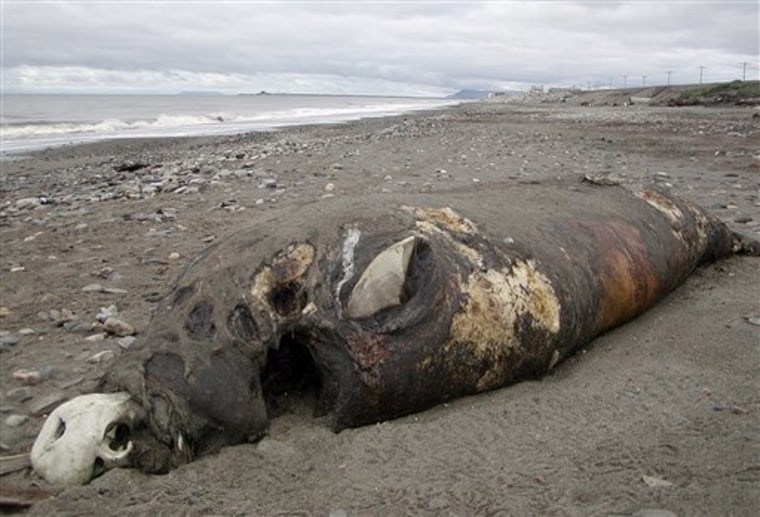Dozens of walrus carcasses have washed up on beaches this summer, many missing their heads and ivory tusks.
While rotting, headless carcasses are not uncommon along beaches in western Alaska in summer, the number of carcasses washing up in Norton Sound has prompted an investigation by the U.S. Fish and Wildlife Service.
Federal authorities don't know if a crime has occurred, said Steve Oberholtzer, a special agent in Anchorage. But he said investigators are looking into two possibilities: either someone who is not Alaska Native is poaching walruses or Alaska Natives are not salvaging enough of the animals.
Only Alaska Natives are allowed to subsistent hunt for walrus. The tusks are often carved or used in Native arts and crafts. Non-Natives can also harvest walrus tusks if they find a carcass. However, non-Natives can't sell or profit from them.
Oberholtzer said Wednesday cases of a non-Native illegally killing a walrus is unusual.
However, he said the agency does have anywhere from one to eight or more cases a year of wasteful take by Alaska Natives.
All heads removed
The federal Marine Mammal Protection Act requires at a minimum the heart, liver, flippers, chest meat with blubber, and some red meat be used, he said. Violators face a maximum $100,000 fine and one year in prison, he said.
In late June and early July, 79 walrus carcasses were counted along a 40-mile stretch between Elim and Unalakleet — about twice as many as in any year in the past decade, Oberholtzer said.
"Every one of them had the head removed," he said.
The ones that investigators got a close look at had been shot, he said.
Pacific walruses are not considered threatened or endangered. The population was estimated at more than 200,000 in 1990, the most recent count. Fish and Wildlife hopes to have a more accurate count by next year.
"There is no evidence that subsistence hunting is causing a problem," said John Trent, lead biologist with the Fish and Wildlife walrus program.
In 2005, Alaska Native subsistence hunters harvested 1,590 walrus. Another 1,470 were killed by Russian subsistence hunters. The total number, including the estimate of those shot but lost in the sea, was 5,276 animals.
"We work very hard with the Alaska Native community to promote effective harvest and minimize losses and waste of any kind," Trent said. "I think most people do try very hard... They absolutely depend on these animals."
Not always illegal practice
Karl Erickson of Unalakleet said he and his father-in-law, brother-in-law and a friend were headed down the coast in June looking for herring eggs on kelp when they came across four walruses.
"The water was a little bouncy so we stayed close to the shore because it was a little smoother in there. As we went down, we bumped into one, took the head, bumped into another, took the head...," Erickson said of the legal practice of harvesting the tusks.
During the trip, they found three dead walruses on the beach and a fourth in the water. All still had their heads. All had been shot.
Erickson said numerous other walruses have washed up on the beaches near Unalakleet this summer.
"Somebody already got to them and cut their heads off," he said.
Erickson's father-in-law, who is Eskimo, is deciding what to do with the tusks.
Erickson said usually the whole head is harvested in order to get the ivory. Two popular methods are used for removing the tusks. The heads are either cooked to loosen the tusks or buried in a hole where maggots eventually eat the flesh and loosen the tusks, he said.
Erickson, who also is a state trooper in Unalakleet, said cases of wasteful take has slowed down in recent years but perhaps "is ramping back up."
Another possibility is that people are shooting walrus in the water instead of on the ice, he said.
"If they get into the water after you shoot them, they will sink almost immediately," Erickson said.
Global warming a factor?
Global climate change and the shrinking of the ice pack could be a factor, Trent said. Sea ice reached a historic minimum earlier this month, he said.
While hunting techniques for walrus vary, most hunters prefer to kill them on large ice floes so that when they die they won't roll off into the water and sink, Trent said.
"I don't know what caused this number of animals, of headless walruses, to come to shore in eastern Norton Sound. I do know the water conditions, ice conditions this year are extremely unusual," he said. "This is the year that the ice edge has been to the furthest north of any recorded year."
Andrew Woods, a police dispatcher in Unalakleet, said two rotting headless carcasses remained on the beach Wednesday. He likes to run and go four-wheeling on the beach.
"I see carcasses all the time on the beach but not this much," he said. "When I'm running I try to get away as fast as possible because it smells so bad."
